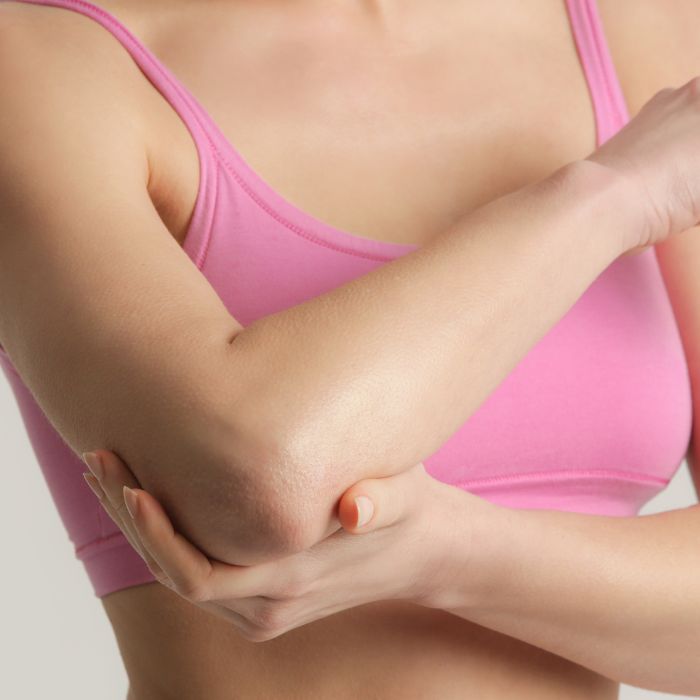Understanding Rough Skin and How to Care for It

Welcome on our new website !
0,00€
Under the fingers, its texture can be felt, thick, granular... Rough skin is characterized by an irregular texture, a dull appearance, with areas of thickened skin . Benign, this common condition can however be a source of physical and psychological discomfort by affecting self-esteem, especially when the affected areas are visible.
If it results from specific physiological factors, rough skin, also called granular skin , can be associated with other skin conditions such as dry skin , keratosis pilaris or psoriasis and accentuate the symptoms and discomfort .
In this article, you will find everything you need to know to recognize rough skin and take care of it.
Rough skin is characterized by an uneven and thick skin texture , which feels granular to the touch. These rough skin areas are mainly the result of poor skin renewal (desquamation) leading to the excessive accumulation of dead skin cells.
Often described as rough, rough skin lacks softness and suppleness , its appearance is rather dull and scales can be particularly visible. It is often dry skin.
It is often found on the arms and legs , elbows and knees , but also on the face (especially around the nose and chin).
Rough skin can appear in many different situations, often due to an imbalance in cell renewal and an alteration of the skin barrier. Certain internal imbalances , such as dehydration, skin aging or lipid deficiencies, can be responsible for a rough and dull texture.
Additionally, some skin conditions , such as keratosis pilaris (small, rough bumps on the arms and thighs), psoriasis, or eczema, cause excessive dryness and unevenness to the touch.
Finally, repeated friction on certain areas of the body, such as elbows, knees or heels, can lead to skin thickening and a marked rough appearance.
The appearance of roughness on the skin is mainly caused by factors of biological origin which can be exacerbated by environmental factors :
Naturally, every 21 to 28 days, the skin renews its cells and eliminates dead cells from the surface through a natural process called " desquamation ". Under the influence of certain factors such as genetics, aging, or environmental factors (pollution, UV, dry climate, stress), cell renewal can be slowed down and desquamation less regular, leading to the accumulation of dead cells . On the surface, the skin then appears thickened and rough⁵
.
To stay hydrated, skin needs lipids and natural moisturizing factors (NMFs) such as urea and amino acids. A deficiency leads to excessive water loss from the skin , promoting dryness and a rough feel⁶.
Certain lifestyles can also influence the appearance of roughness on the skin, such as a diet lacking in essential nutrients (fatty acids, vitamins, antioxidants), insufficient water consumption or the use of unsuitable or aggressive skincare products.

As you can see, rough skin can be seen and felt. Here are some characteristic signs to help you recognize it.
This is sometimes accompanied by a feeling of discomfort with tightness and itching .
Roughness can appear in different areas, more or less visible:
Rough skin, like other skin conditions, can cause physical and psychological discomfort and discomfort . Additionally, when it is linked to skin conditions such as psoriasis, it can exacerbate the physical and emotional problems associated with them.
Rough skin can then be a source of aesthetic discomfort, leading to a loss of self-confidence and a feeling of discomfort in social interactions.
Overall, several studies show the psychological impact of skin conditions characterized by rough, thicker, and uncomfortable skin.
If we take the example of psoriasis, reports from the WHO (World Health Organization) have reported that 94% ⁷ of those affected feel a social impact associated with psychological distress (embarrassment, low self-esteem, feeling of stigma, etc.).
Therefore, appropriate care is essential to better live with rough skin. Targeted care and appropriate lifestyle habits will allow you to feel better in your skin and regain smoother, more supple, more comfortable, and more beautiful skin.
Here are some easy and practical tips for taking care of your rough skin.

Urea is a natural compound in the skin. It is part of the natural moisturizing factor (NMF), a group of molecules capable of retaining water in the epidermis. Urea is an essential element in maintaining skin hydration and the proper functioning of the skin barrier .
In dermatology, urea is a popular ingredient for the effectiveness of its unique properties, both moisturizing and keratolytic (exfoliating), and is a key active ingredient in skincare products for dry, thickened or rough skin.
The effectiveness of urea depends heavily on its concentration. Depending on the dosage, it addresses different skin needs.
Thanks to this dual action, urea is a versatile ingredient, perfectly suited to rough skin , which it helps to regain softness, suppleness and comfort on a daily basis.

The Topicrem answer:
To take care of your rough skin , discover our DERMO SPECIFIC range based on urea with the UR-10 Anti-Roughness Smoothing Cream containing 10% urea and the UR-30 Soothing Anti-Roughness Cream containing 30% urea. Formulas developed to exfoliate, smooth, reduce scales and soothe the itching and discomfort of rough skin.
While rough skin is a common problem , it is possible to limit its discomfort. Adopting a few simple daily actions and a suitable skincare routine will allow you to take care of it and make it more comfortable . And because your skin is unique, it is important to listen to it and adapt your routine according to its sensitivity and reactions. And we are here to help you.
TOPICREM formulas have all been designed to provide protective hydration and preserve the skin barrier of sensitive skin for the whole family.
To do this, the laboratory relies on its expertise derived from pharmaceutical excellence:
Through the comfort and emotional well-being they provide, our treatments help you feel confident in your skin and in yourself, to better reveal yourself to others, and thus to fully enjoy every moment of life.
Bibliographic references:
¹Pons-Guiraud A. Dry skin in dermatology: a complex physiopathology. J Eur Acad Dermatol Venereol. 2007 Sep;21 Suppl 2:1-4. doi: 10.1111/j.1468-3083.2007.02379.x. PMID: 17716284.
²Drivenes JL, Vasilescu IC, Bygum A. Keratosis pilaris. Tidsskr Nor Laegeforen. 2023 Mar 7;143(5). English, Norwegian. doi:10.4045/tidsskr.22.0513. PMID: 36987905.
³Frazier W, Bhardwaj N. Atopic Dermatitis: Diagnosis and Treatment. Am Fam Physician. 2020 May 15;101(10):590-598. PMID: 32412211.
⁴Armstrong AW, Read C. Pathophysiology, Clinical Presentation, and Treatment of Psoriasis: A Review. JAMA. 2020 May 19;323(19):1945-1960. doi:10.1001/jama.2020.4006. PMID: 32427307.
⁵Has C. Peeling Skin Disorders: A Paradigm for Skin Desquamation. J Invest Dermatol. 2018 Aug;138(8):1689-1691. doi: 10.1016/j.jid.2018.05.020. PMID: 30032785.
⁶Proksch E, Berardesca E, Misery L, Engblom J, Bouwstra J. Dry skin management: practical approach in light of latest research on skin structure and function. J Dermatolog Treat. 2020 Nov;31(7):716-722. doi:10.1080/09546634.2019.1607024. Epub 2019 Jun 19. PMID: 30998081.
⁷Global report on PSORIASIS (WHO). https://www.who.int/news/item/26-02-2016-who-publishes-new-report-on-psoriasis




